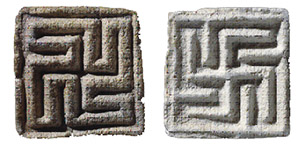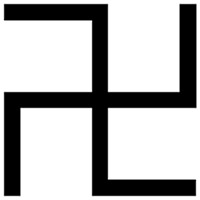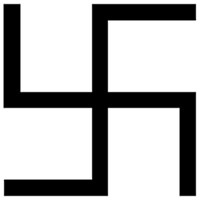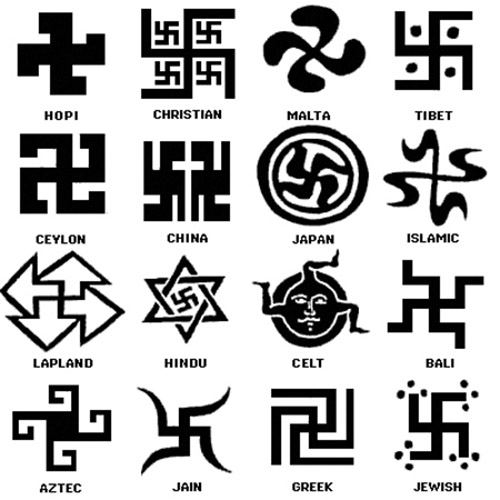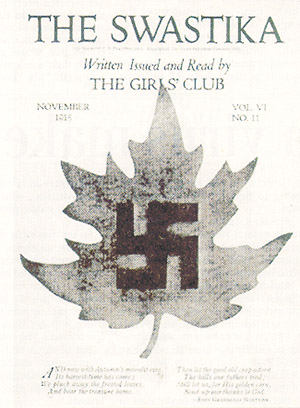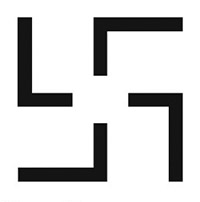From New Dawn Special Issue Vol 10 No 2 (May 2016)
If you were asked to come up with a symbol for evil, very likely you would think of the swastika. The quintessential emblem of the Third Reich, it still evokes hatred and fear seventy years after the collapse of the Nazi regime.
And yet not so long ago it was a symbol of blessings and good fortune. Even its name is derived from Sanskrit roots meaning “it is good.” (Other names given to it include the cross patteé, the gammadion, the hakenkreuz or hooked cross, and the fylfot.) Today, in a somewhat truncated form, it still occupies a place in the official symbol of the Theosophical Society.
The peculiar fate of the swastika has a great deal to teach about the nature and meaning of symbols – and about the uses to which they can be put.
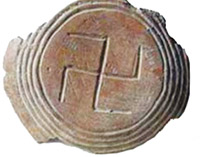
Pottery fragment with swastika, dating to 7,000 years ago, from Bulgaria.
The swastika occurs almost universally. The most ancient version known is on a carved tusk from the Ukraine, dated to around 10,000 BCE. Other early instances were found at Hissarlik in western Asia Minor, where Heinrich Schliemann, often called the father of archaeology, unearthed the ruins of Troy in 1873. The swastika begins to appear in the city’s third stratum, dated to 2250–2100 BCE. It is on spindle-whorls, a sphere, and a statue made of lead thought to be an image of the goddess Artemis. The vulva (or perhaps the mons veneris) of this figure has a swastika in the middle. One scholar interpreted it as representing “the generative power of man.”1
Schliemann himself, following orientalist scholars of his time, said that the swastika was “of the very greatest importance among the early progenitors of the Aryan races in Bactria and in the villages of the Oxus, at a time when Germans, Indians, Pelasgians, Celts, Persians, Slavonians and Iranians still formed one nation and spoke one language.”2
But the swastika is found far beyond the traditional provenance of the “Aryan races.” Thomas Wilson, who wrote a study on it for the Smithsonian Institution in the late nineteenth century, lists examples from ancient sites ranging from Japan to Europe to North and South America. It’s quite apparent that the swastika belongs to everybody and to nobody.
Before we go into the swastika’s history, it might be best to clear up one source of confusion: its orientation. You will often hear it said that the “clockwise” direction of the swastika is the “good” direction, while the “counterclockwise” direction is the “bad” one.
To begin with, consider these two images:
Which of these looks clockwise to you? To me, either one could be seen as clockwise, or counterclockwise, so I will avoid these terms. Instead I will speak of “left-facing” (for diagram 1) and “right-facing” (for diagram 2) swastikas. (If you’re curious, the left-facing one is most often described as clockwise.)
You can also forget about which direction is the good one or the bad one. Traditionally there seems to be no difference, and often both types appear in the same location – for example, on the curtain of a Tibetan temple devoted to the Bönpa, the nation’s pre-Buddhist shamanistic religion.3 Similarly Thomas Wilson, introduced to a member of a Chinese delegation visiting Washington, found him wearing robes of state emblazoned with both versions of the swastika. “The name given to the sign was… wan, and the signification was ‘longevity’, ‘long life’, ‘many years’,” Wilson writes. “Thus was shown that in far as well as near countries, in modern as well as ancient times, this sign stood for blessing, good wishes, and, by a slight extension, for good luck.”4
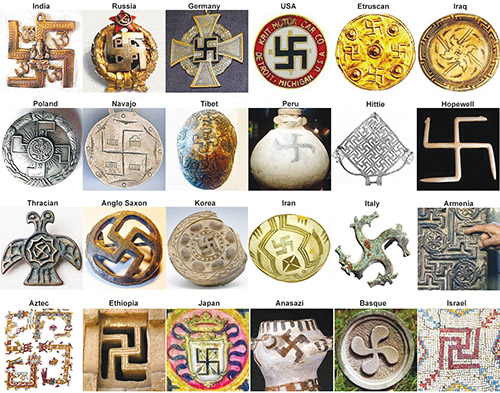
The swastika occurs almost universally across the world in diverse cultures, religions and regions. Above are just some of the swastika’s renditions in art and religious symbolism.
Swastika: From Good to Evil Symbol
So how did it come to stand for the complete opposite: hatred, violence, and cruelty?
Some historical background is needed. In 1871 Germany, which for centuries had been fragmented into dozens of tiny and often overrun states, was unified into a single empire, or Reich, by the Prussian chancellor Otto von Bismarck. Naturally Germans began to feel a thirst for a shared national identity. This began to form under a range of influences, from the treatise on Germany by the Roman historian Tacitus to the operas of Richard Wagner.
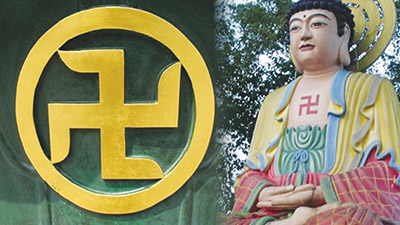
An identity is created out of many things, including the things you are against. Thus anti-Semitism soon became part of this German identity. Anti-Semitism had deep roots in Germany, going back at least as far back as Martin Luther, who in 1543 published a vituperative book entitled On the Jews and Their Lies.
Opposed to the Jews were, so the theory went, the Aryans. The word comes from the Sanskrit arya, meaning “noble,” and originally referred to the Indo-European peoples who conquered the Indian subcontinent in the second millennium BCE. But soon it came to mean, above all else, the pure, white European race, which had reached the summit of perfection in the Germans.
What could serve as a symbol for this race? The cross was tainted by Christianity, which after all was founded by Jews. The fact that Schliemann had found the swastika in the ruins of Troy and Mycenae, the homes of an ancient, noble, and presumably Aryan race, spoke in its favour. It was (and is) found universally in India too, which had given the Aryans their name. And there was the verdict of the French symbologist the Count Goblet d’Alviella, who asserted that the swastika “is not met with in Egypt, Chaldea, or Assyria” – the last two being Semitic nations.5
By the twentieth century, occult and pseudo-occult groups invoking the Aryan legacy were displaying the swastika. Hitler’s connection with these groups is suppositional at best, but it is fairly certain that he read and collected issues of the journal Ostara, founded in 1905 by the occultist Jörg Lanz von Liebenfels. The magazine’s subtitle – “Newsletter of the Blonds and Male Supremacists” – gives a good idea of its orientation. Its emblem was a knight in a hooded robe covered with swastikas.
Other extreme groups made use of the symbol as well, such as the Germanenorden, an occult lodge focused on ancient Germanic lore and of course anti-Semitism. Its founder was a self-styled aristocrat named Rudolf von Sebottendorff. As the German Reich collapsed in the fall of 1918, the order recast itself as the Thule Society (after Thule, a mythical polar land). Its symbol was a long dagger superimposed on a swastika sun wheel.
On 9 November 1918 – two days before Germany’s surrender in World War I – Sebottendorff delivered an impassioned speech to the Thule Society. Because of the imminent defeat, he declaimed, “in the place of our princes of Germanic blood rules our deadly enemy: Judah.” He urged his audience to fight “until the swastika rises victoriously out of the icy darkness.”6
Direct connections between the Thule Society and the nascent Nazi movement are somewhat hard to trace, but there was at the very least an overlap of membership. In May 1919 a Thule member named Friedrich Krohn proposed the left-facing swastika as a symbol for the Deutsche Arbeiterpartei (“German Workers’ Party,” or DAP), the precursor of the Nazi party.
Krohn evidently preferred this direction because he considered it auspicious, whereas he said the right-facing version portended disaster and death. But as Nicholas Goodrick-Clarke writes in his Occult Roots of Nazism, “there was no standard usage regarding the swastika” in this movement (or, as far as I can tell, anywhere else). The Germanenorden itself had used the right-facing version. Finally Hitler, who joined the party in November 1919 and soon rose to its leadership, chose the right-facing version, for reasons that are not clear.7
But the meaning was clear. In his autobiography, Mein Kampf, Hitler writes: “The swastika signified the mission allotted to us – the struggle for the victory of Aryan mankind and at the same time the triumph of the ideal of creative work which is in itself and always will be anti-Semitic.” He credits himself with the design:
After innumerable trials I decided upon a final form – a flag of red material with a white disc bearing in its centre a black swastika. After many trials I obtained the correct proportions between the dimensions of the flag and of the white central disc, as well as that of the swastika… The new flag appeared in public in the midsummer of 1920. It suited our movement admirably, both being new and young. Not a soul had seen this flag before; its effect at that time was something akin to that of a blazing torch.8
This, by the way, is the standard Nazi swastika:
Notice one thing about this version. As figures 1 and 2 indicate, the traditional forms of the swastika appear in full vertical and horizontal orientation. But the Nazi swastika is decussated: it is cocked to a tilt of 45 degrees. This gives a greater impression of movement, possibly of a destructive kind. In this position it looks like a whirling blade. Hitler may have adopted it for this reason.
Nevertheless, the swastika did not have these meanings elsewhere in the world. In the US it remained a good-luck sign, as evidenced by its use in the house organ of the Girls’ Club, called The Swastika (left). Up to the 1930s, the symbol appeared – with perfectly innocent intentions – on American goods ranging from poker chips and playing cards to the labels of fruit boxes. It was even the emblem of a lovable cartoon monkey named Bing-o. To this day in Asia it is still used, with auspicious connotations, on commercial signs and in religious ritual.9
But after Hitler came to power in 1933, the Western world came to link the swastika with hatred and violence. A synagogue in Hartford, Connecticut, had swastika patterns in its flooring, which the horrified congregation had to have paved over. When swastika flags were hoisted over three ocean liners docked in New York in 1935, a mob of 2,000 people tore them down, provoking diplomatic protests from the Nazis. The swastika became so firmly equated with evil that it remains an emblem of fear for many – and for many others, it is still used for that purpose. The incarcerated cult leader Charles Manson carved it into his forehead in 1970.10 It continues to surface among anti-Semites and fascists of various stripes. The present-day German republic forbids its public display.
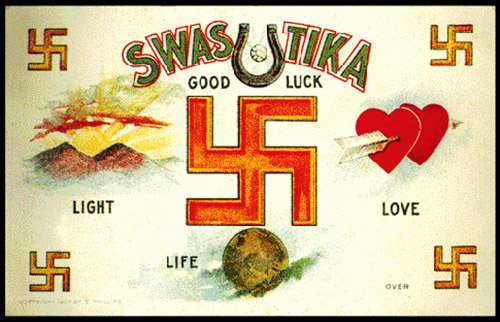
The swastika appeared – with perfectly innocent intentions – on American goods ranging from poker chips and playing cards to the labels of fruit boxes. Above: Early 20th century postcard.
What Does the Swastika Actually Symbolise?
All this gives a brief history of the use and abuse of the swastika in modern times. But what does the symbol really mean? This question is, I believe, not only difficult but unanswerable. But before I say why, let’s explore some of the meanings that have been ascribed to it.
One interpretation is given by Schliemann, citing a scholar named Émile Bournouf:
The 卐 represents the two pieces of wood which were laid cross-wise upon one another before the sacrificial altars in order to produce the holy fire (Agni), and whose ends were bent round at right angles and fastened by means of four nails, so that this wooden scaffolding might not be moved. At the point where the two pieces of wood were joined, there was a small hole, in which a third piece of wood, in the form of a lance (called Pramantha) was rotated by means of a cord made of cow’s hair and hemp, till the fire was generated by friction.11
The swastika is thus associated with fire – particularly the sacred fire known as agni, which is not to be confused with the physical manifestation per se. Because this fire is caused by friction, the swastika is also associated with motion. And from its shape, it is connected with the cross. Thus the swastika can represent a cross in motion. George S. Arundale, late president of the Theosophical Society, writes:
All that you feel in the sea you can feel infinitely more in the whirling of the Svastika [sic], for you yourselves are part and parcel of the whirling. The Svastika whirls because a God has set in motion the Wheel of the Law, and it is as if to its myriad spokes clung innumerable drops – the Men who are to become Gods.12
This passage is taken from Arundale’s Lotus Fire, a profound work that explores a sequence of symbols (the point, the web, the line, the circle, the cross, the swastika, and the lotus) that was, he claimed, “disclosed to me by a Lord of Yoga.”13 Arundale also observes:
I see… a very special appearance of relentlessness to the movement of the Svastika and to its effect upon the Men of the Sea [i.e., unindividuated beings] whom it frictions into ever-increasing Self-consciousness. The well-known phrase “broken on the wheel” – that horrible physical torture of earlier periods of history, perpetuated in modern days in terms of the mind, so that the inquisition of today is breaking its victims on the wheel of the mind, a terrible desecration of the Wheel of the Law… – occurs to me, for indeed [it is] ignorance which is broken upon the Wheel of the Love of God, the Wheel of His Salvation, the Svastika (emphasis added).14
Although Arundale is writing in the 1930s, he does not seem to have Nazism per se in mind. Nevertheless, his association of the swastika with relentlessness and with “breaking on the wheel” suggests a possible bridge between its ancient, esoteric meaning and its present sinister connotations.
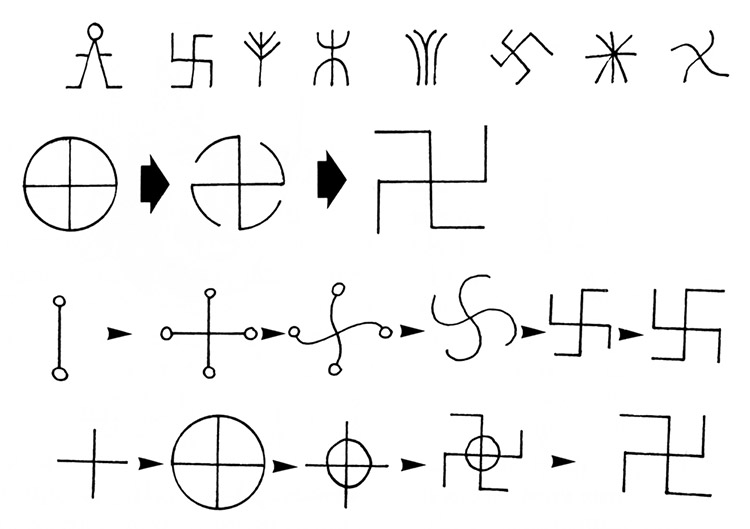
The evolution of the swastika. Top line (1): Hallristningar, ancient Scandinavian rock-scribings. (2): In The Book of Signs, Rudolf Koch suggested the swastika evolved by the breaking of a sunwheel’s circumference. (3): In 1933, Herman Wirth said the swastika evolved from a runic character. (4): In his book The Sacred Symbols of Mu, James Churchward claimed the swastika had begun with the simple cross.
H.P. Blavatsky, identifying the swastika with “Thor’s hammer” or “the hammer of creation,” says:
In the Macrocosmic work, the “Hammer of Creation,” with its four arms bent at right angles, refers to the continual motion and revolution of the invisible Kosmos of Forces. In that of the manifested Kosmos and our Earth, it points to the rotation in the circles of Time of the world’s axes and their equatorial belts; the two lines forming the Svastika 卐 meaning Spirit and Matter, the four hooks suggesting the motion in the revolving cycles (emphasis Blavatsky’s).15
Other authorities have also linked the swastika to cosmic cycles. The French esotericist René Guénon writes:
The bent part of the arms of the swastika is considered… as representing the Great Bear seen in four different positions in the course of its revolution around the Pole Star, to which the centre of the four gammas are united naturally corresponds, and that these four positions are related to the cardinal symbol points and the four seasons.16
Guénon is talking about the fact that the four arms of the swastika resemble four gammas (the Greek capital gamma looks like this: Γ) positioned around a centre point. He connects this fact with the symbolism of the letter G – the Roman equivalent of the gamma – in Masonry. Hence also the name gammadion.
Furthermore, this centre point would be the pole. (The point of view would be of someone looking down at the earth from above the North Pole.) For this reason, Guénon associates the swastika with Hyperborea, a prehistoric circumpolar civilisation that was said to precede Atlantis.17 (Note: this is not to be confused with Blavatsky’s concept of the Hyperborean Root Race.)
So, then, the swastika is, or may be, connected with the four principal directions, portrayed symbolically as a cross. If so, then the decussated Nazi swastika would symbolise directions that are askew, and hence a world out of joint, possibly evil.

Incidentally one could say the same thing about the Soviet hammer and sickle. In essence it is nothing other than the cross (in this case, a T-cross) combined with the crescent – two of the most ancient and universal sacred symbols. But again its orientation is not rectilinear. Like the Nazi swastika, it is decussated – again suggesting something that is aberrant, out of joint, or evil.
At any rate, these are some of the esoteric meanings associated with the swastika: sacred fire (or primordial energy), a cross in motion, movement, the North Pole and the four directions. Of course they do not contradict each other, because a symbol is a nexus of meanings and associations, not a series of propositions that can be consistent or inconsistent.
Earlier I said that none of these associations, singly or as a whole, exhausts the meaning of the swastika. That’s because the swastika, like all other primordial symbols, has no ultimate meaning. It means itself. It speaks to a level of the mind that lies beyond the realm of meaning as we normally understand it. The same is true of other basic geometric shapes such as the six-pointed star and the crescent, the defining symbols of Judaism and Islam. These symbols will keep their living force for as long as the human mind is as it is. Meanings and movements will attach themselves to them and will try to draw power from them, often with success. Yet meanings come and go, while the symbol remains.
As theologian Paul Tillich writes, religious symbols open “the depth dimension of reality itself, the dimension of reality which is the ground of every other dimension and every depth… the fundamental level, the level below all other levels, the level of being itself… If a religious symbol has ceased to have this function, then it dies. And if new symbols are born, they are born out of a changed relationship to the ultimate ground of Being, i.e., to the Holy.”18
I believe that Tillich is right up to a point, but it is not so obvious to me that symbols – the primordial symbols, at any rate, of which the swastika is one – die. Or if they die, they are born again. Maybe it would be more accurate to say that they are recycled.
In recent years some have tried to cleanse the swastika of its evil connotations. In 1988–92 a Jewish artist named Edith Altman created an installation entitled Reclaiming the Symbol: The Art of Memory. In one scene, she has a gold swastika painted on a wall above a black Nazi swastika painted on the floor – a visual attempt to expunge evil from the symbol. In 2008, in a ham-handed effort to make the swastika humorous, cartoonist Sam Gross published We Have Ways of Making You Laugh: 120 Funny Swastika Cartoons. (Sample: a Nazi dropping garbage into a swastika-shaped bin labelled “White Trash Only.”)
But as graphic artist Steven Heller comments: “For every naïve rock-and-roller who thinks the swastika can be used with irony, there is a fervent neo-Nazi who uses it with malice. For every well-meaning artist who thinks the swastika can be tamed, there is a devout racist who embraces it.”19
In the long run, it’s likely that the swastika will be rehabilitated. Theosophist Arthur M. Coon observes:
The memory of the use of the swastika, as an emblem of Nazism will in future ages have faded to oblivion; while its true meaning as a symbol of the hidden “fire” or “spirit” within all manifestation, from the atom to a solar universe, will become increasingly revealed to humanity.20
But I suspect that these future ages will not, at least in the West, come in the lifetime of anyone who is breathing on this planet now.
This article first appeared in Quest: Journal of the Theosophical Society in America (Winter 2016), and is reprinted with permission.
Footnotes
1. Thomas Wilson, The Swastika: The Earliest Known Symbol and Its Migrations, with Observations on the Migrations of Certain Industries in Prehistoric Times, Government Printing Office, 1896, 811–13, 829
2. Henry [Heinrich] Schliemann, Troy and Its Remains: A Narrative of Researches and Discoveries Made on the Site of Ilium, and in the Trojan Plain, Edited by Philip Smith, John Murray, 1875, 102
3. Christoph Baumer, Tibet’s Ancient Religion: Bön, Translated by Michael Kohn, Weatherhill, 2002, 21
4. Wilson, 800
5. Count Goblet d’Alviella, The Migration of Symbols, Archibald Constable, 1894, 40
6. Nicholas Goodrick-Clarke, The Occult Roots of Nazism: Secret Aryan Cults and Their Influence on Nazi Ideology, New York University Press, 1985, 144–45
7. Ibid., 151
8. Adolf Hitler, Mein Kampf, Translated by James Murphy, chapter 7, www.greatwar.nl/books/meinkampf/meinkampf.pdf; accessed Aug. 27, 2015
9. Steven Heller, The Swastika: Symbol beyond Redemption?, Allworth, 2000, 37, 90–101, 149
10. Ibid., 13
11. Schliemann, 103–04; cf. H.P. Blavatsky, Collected Writings, 15 vols., Edited by Boris de Zirkoff, Theosophical Publishing House, 1966–91, 2:143–44
12. George S. Arundale, The Lotus Fire: A Study in Symbolic Yoga, Theosophical Publishing House, 1939, 225
13. Ibid., 22
14. Ibid., 267–68
15. H.P. Blavatsky, The Secret Doctrine, 2 vols., Quest, 1993, 2:99
16. René Guénon, Fundamental Symbols: The Universal Language of Sacred Science, Translated by Alvin Moore, Jr., Quinta Essentia, 1995, 85
17. Jason Jeffrey, “Hyperborea and the Quest for Mystical Enlightenment,” New Dawn 58 (Jan.-Feb. 2000), www.newdawnmagazine.com/articles/hyperborea-the-quest-for-mystical-enlightenment; accessed Sept. 1, 2015.
18. Paul Tillich, The Essential Tillich, Edited by F. Forrester Church, Macmillan, 1987, 47, 49
19. Heller, 157
20. Arthur M. Coon, The Theosophical Seal: A Study for the Student and the Non-Student, Theosophical Publishing House, 1958, 120
© New Dawn Magazine and the respective author.
For our reproduction notice, click here.



